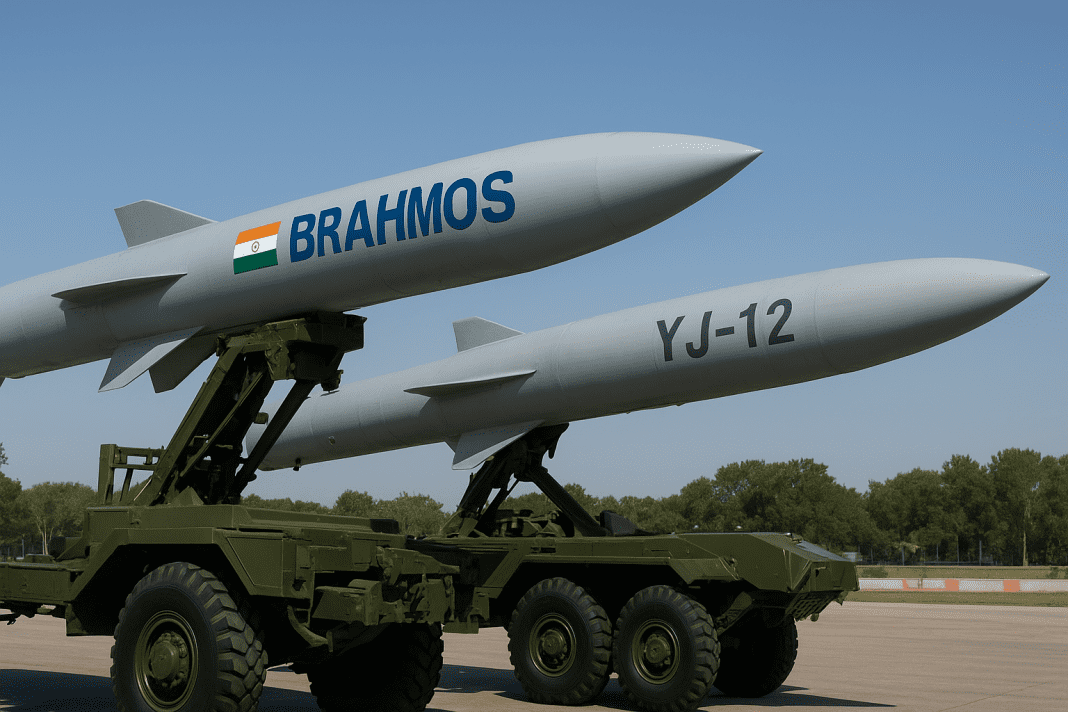China displayed its new YJ-12 ‘killer missile’ capable of Mach-6 speeds, drawing comparisons with India’s BrahMos. Both missiles showcase advanced military technology, with key differences in speed, range, and accuracy.
BrahMos and YJ-12 Speed and Range: How Far Can They Strike?
Recently, China displayed its most dangerous weapons during a military parade on Victory Day. Among all the weapons, the YJ-12 missile attracted the most attention. China calls this missile a ‘killer missile,’ claiming it can reach speeds up to six times the speed of sound, or Mach-6. According to China, such high speed makes it almost impossible for any air defense system to intercept.
Many experts and enthusiasts are comparing this missile with India’s BrahMos. The comparison is gaining importance as both missiles represent the forefront of missile technology in Asia.
The YJ-12 missile has several reported ranges. At the 2016 Zhuhai Airshow, its range was listed as 290 km, while the United States Naval War College Review reported up to 400 km. Experts often consider its range to be around 300 km on average. The missile can travel at a speed of Mach-4.
India Unleashes BrahMos-Powered Frigate ‘Tamal’ from Russia’s Kaliningrad
The BrahMos missile, initially with a range of 290 km, has now been extended to 350 km. Its maximum speed reaches Mach-3.5. While the YJ-12 has a slight edge in speed, the difference in performance between the two missiles cannot be considered decisive. Both are extremely fast and capable of delivering powerful strikes. BrahMos, however, remains highly reliable and precise in operational conditions.
Propulsion, Accuracy, and Guidance Systems
BrahMos is a multi-stage missile. Its first stage uses a solid fuel rocket booster, while the second stage uses a liquid fuel ramjet engine. This design is light, reliable, and easy to maintain. In comparison, YJ-12 uses an integrated ramjet system, which may make it less versatile in performance than BrahMos.
When it comes to guidance, BrahMos uses a two-stage system. It combines inertial navigation with satellite navigation. In the final stage, it locks onto the target using active radar homing and a ‘fire and forget’ system. YJ-12 relies on inertial guidance and China’s Beidou Satellite System. For terminal homing, it uses an active radar seeker with claimed accuracy of more than 90%.
The circular error probability, or CEP, indicates how precisely a missile hits its target. BrahMos has an impressive CEP of just 1 meter, meaning it is highly accurate. YJ-12 has a CEP of 5–7 meters, which is slightly less accurate. This shows that while YJ-12 is fast, BrahMos has a significant advantage in precision.
Strategic Boost to Indo-Filipino Defense Relationship Amid Heightened Tensions in South China Sea
Radar protection is another key factor. BrahMos can fly as low as 3–4 meters above sea level. This sea-skimming ability allows it to avoid enemy radar. YJ-12 also features sea-skimming technology, but detailed information remains confidential.
In terms of launch platforms, BrahMos is highly versatile. It can be fired from land, water, and air. Warships, submarines, mobile launchers, and fighter aircraft can all deploy BrahMos. Indian forces have already equipped destroyers with this missile, and it has been deployed in strategic locations like eastern Ladakh. Upcoming aircraft like MiG-29K, HAL Tejas, and Rafale will also be compatible with BrahMos-NG, an advanced version of the missile.
Features of BrahMos and Limitations of YJ-12
The YJ-12 missile can be launched from air and land platforms. Its export version, CM-302, is promoted as one of the world’s best anti-ship missiles. This version can reportedly destroy a 5,000-tonne warship. Several Chinese fighter jets and bombers can carry YJ-12. China’s navy, including four Sovremenny-class destroyers, is equipped with these missiles.
Looking at future developments, India is working on BrahMos-II. This upgraded missile will reportedly have a range of 600–800 km and reach speeds up to Mach-8. China is also developing export variants like CM-302 and CM-400AKG. The CM-400AKG, nicknamed ‘Recker,’ is described as a hypersonic missile capable of exceeding Mach-5.5 in its terminal phase. Pakistan has reportedly signed a deal to acquire 60 units of this missile in 2020.
Indonesia’s $450M BrahMos Missile Deal Sparks Regional Tensions
Both BrahMos and YJ-12 are powerful missiles with unique strengths. YJ-12 is faster, while BrahMos is more accurate and versatile in launch options. Both countries continue to develop advanced variants to enhance range, speed, and precision. BrahMos remains a reliable cornerstone of India’s missile arsenal, known for its accuracy and operational flexibility.
